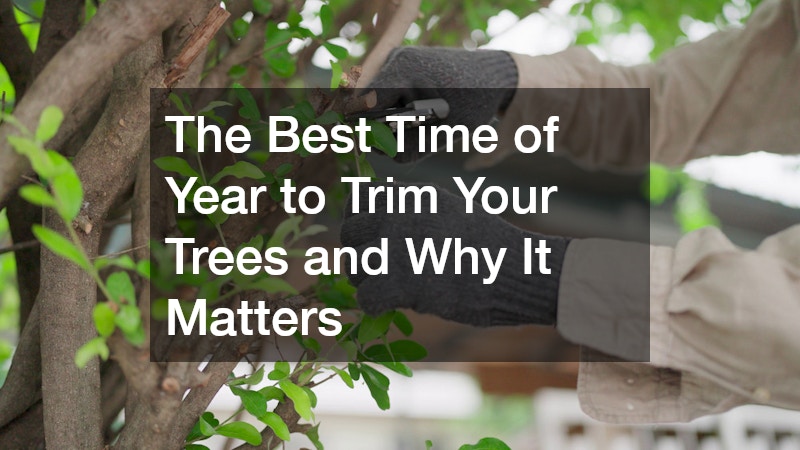Understanding the optimal time for tree trimming is crucial for maintaining the health, appearance, and safety of your trees. This article explores the best times to prune, the reasons behind these recommendations by tree trimming services, and answers to common questions on the topic. With a combination of scientific insights and practical tips, you will be well-equipped to manage your tree maintenance efficiently.
The Best Season for Trimming Trees
Late Winter Dormancy and Its Benefits
Late winter is often considered the best time for trimming trees because most trees are dormant during this period. Dormancy means that trees are in a resting phase and not actively growing, which reduces the risk of stress from pruning.
Additionally, trimming during dormancy helps minimize sap loss, which can be beneficial for the health of the tree.
The reduced sap flow during winter dormancy also decreases the chance of attracting pests that thrive on sap. This makes late winter an optimal period for pruning without the added concern of pest infestations. Moreover, the absence of foliage allows for a clearer view of the tree’s structure, making it easier to identify branches that need trimming.
Understanding Seasonal Variations
Different tree species have varying requirements when it comes to trimming, necessitating an awareness of seasonal variations. Deciduous trees, for instance, usually benefit from late winter or early spring pruning, while evergreen trees might require summer trimming. Understanding these differences ensures that each type of tree receives the care it needs to thrive.
Certain trees, like fruit trees, have unique pruning schedules that coincide with their fruit-bearing cycles. Pruning a fruit tree too early or too late in the season can impact fruit production, underscoring the importance of timing. Ensuring that each species is pruned at a time that suits its specific cycle is critical for optimal health and yield.
Considerations for Flowering Trees
Flowering trees require special attention when it comes to pruning, as improper timing can affect their blooming cycle. Most flowering trees should be pruned immediately after they finish blooming to ensure a full display of flowers the following season. This timing respects the tree’s natural cycle and supports its aesthetic appeal.
Pruning flowering trees at the wrong time can result in fewer blooms and stunted growth. For example, pruning in early spring can remove buds that were meant to bloom in the spring, diminishing the tree’s floral display. Attention to the specific blooming cycle of each flowering tree type helps maintain its health and visual impact.
How Timing Matters for Tree Health
Preventing Disease and Pest Infestations
The timing of tree trimming can significantly affect the likelihood of disease and pest infestations. Trimming at the wrong time, particularly when trees are most vulnerable, can open pathways for diseases and pests to invade. Ensuring that pruning is done during dormancy or other appropriate periods minimizes these risks.
For instance, trimming in late winter when tree activity is minimal allows for quicker healing and less exposure to pathogens. Some diseases, like oak wilt, spread more aggressively when trees are trimmed during their active growing season. By understanding these dynamics, gardeners can time their pruning to safeguard against infection.
Enhancing Tree Growth and Structure
Proper trimming at the right time can promote healthier growth and improve the structural integrity of a tree. By removing dead or weak branches during dormant periods, trees can allocate their energy more efficiently to new growth. This strategic pruning encourages a more robust and resilient structure.
Timing also plays a critical role in directing growth patterns. For example, removing certain branches can stimulate growth in desired areas, improving both the form and function of the tree. The careful timing of these practices supports balanced growth, which is crucial for the long-term stability of trees.
Common Mistakes That Should Be Avoided
Trimming During the Growing Season
One of the most common mistakes in tree trimming is doing so during the growing season. During active growth, trees use their energy reserves to develop new leaves and shoots, and trimming can disrupt this process. The stress of losing branches at this time can weaken the tree.
The risk of infection and pest invasion also increases when trees are cut while actively growing. Open wounds from pruning are more susceptible to diseases and infestations during this period, making it an inopportune time for trimming. Avoiding this common mistake involves understanding and adhering to the natural rhythms of tree growth.
Over-pruning and Its Consequences
Over-pruning is another frequent error that can severely impact tree health and growth. Removing too many branches at once not only affects the tree’s appearance but also compromises its ability to perform photosynthesis effectively. This mistake often results in weakened trees that struggle to recover.
The limitations in foliage from over-pruning can impede a tree’s energy production, influencing its overall vigor and resilience. The resulting imbalances make trees more vulnerable to diseases and environmental stresses. To avoid these issues, it is crucial to adopt a more conservative approach to trimming that considers the tree’s natural capabilities.
Properly timing your tree trimming efforts is essential for ensuring tree health, safety, and aesthetic beauty. By understanding the best practices and avoiding common pitfalls, you can maintain thriving trees throughout the year. Equipped with this knowledge, homeowners and gardeners alike can promote healthier landscapes that endure through changing seasons.
.


